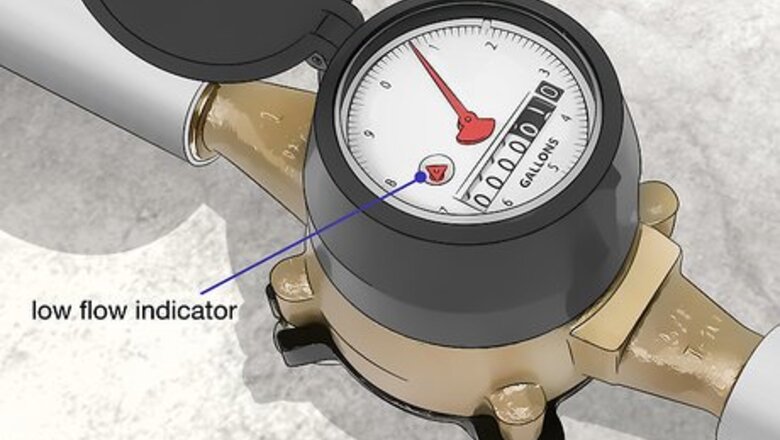
views
Locating the Leak
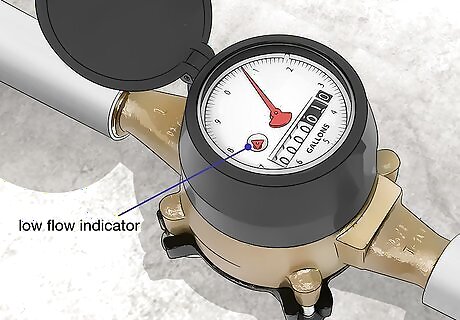
Read the low flow indicator on your water meter to see if the leak is outside. Look on your home’s water meter for a small triangular dial in the center labeled “Low Flow Indicator.” Watch the triangle to see if it rotates, which means there’s a water leak somewhere inside or outside your home. Find the water supply valve for your irrigation system near the water meter and turn the handle so it’s perpendicular to the pipe. Look at the low flow meter on your meter, and if the triangle stops spinning, then the leak is happening in the irrigation system.Tip: If your low flow indicator still rotates after you shut off the supply to the irrigation system, then the leak is somewhere else in your home.
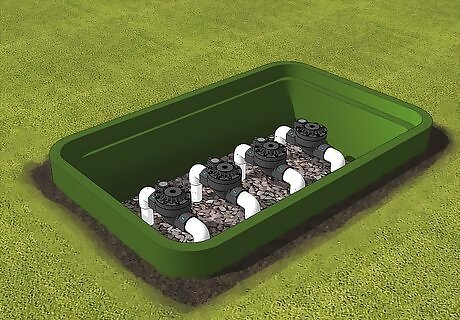
Check your irrigation system’s valve boxes to see if there’s a leak in the valves. Locate the sprinkler valve boxes, which are usually hidden underneath hard plastic or metal lids in your yard near the sprinkler heads. Lift the lid of each of your valve boxes and check the soil to see if it’s wet. If there’s standing water inside one of the valve boxes, then the leak may be occurring because debris is trapped in the valve. If the boxes are dry, then the leak may be located somewhere else in your yard. The number of valve boxes in your yard depends on how many sprinklers you have attached to your system. Smaller systems may only have 1-2 valve boxes, but larger systems may have multiple spread throughout the yard. If you aren’t sure where your valve boxes are in your yard, call an irrigation professional to inspect your system for you.
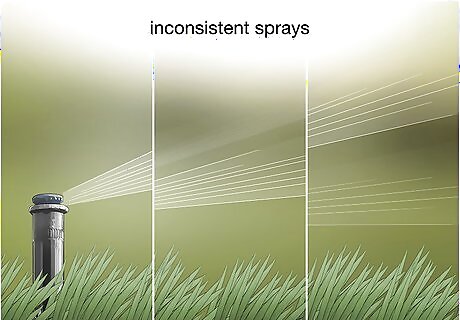
Note that flooding or inconsistent sprays from sprinklers may be a faulty connection. Rotate the dial on the irrigation system’s controller to turn on individual sprinkler zones, and watch how the sprinklers work while they’re running. If the sprinkler head has a weak flow or doesn’t spray as efficiently as normal, then you may have an issue with the hose connection or a clog in the filter. When you notice a problem with a sprinkler head, mark it with a stake flag so you’re able to locate it while the system is turned off. Inconsistent spray could also happen due to a leaking valve or a broken hose. You can buy stake flags from your local hardware store.
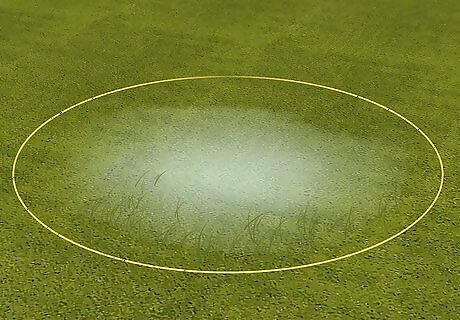
Watch your yard for pools of standing water to see if you may have a broken hose. When you run your irrigation system, look between your sprinklers to see if you notice any water pooling there. Flooding in a specific area of your yard may mean the hose or pipe underneath the area is broken and needs to be replaced. Once you determine where the water is pooling, mark off the area with stake flags so you know where to dig to replace a section of the hose. Water may not pool in an area if you live on a slope or if the leak is small. If you’re still unable to locate where the leak is occurring, turn off the water supply to your system and call an irrigation specialist to look for you. They may be able to find the leak and offer repair services for it.
Cleaning the Solenoid Valve
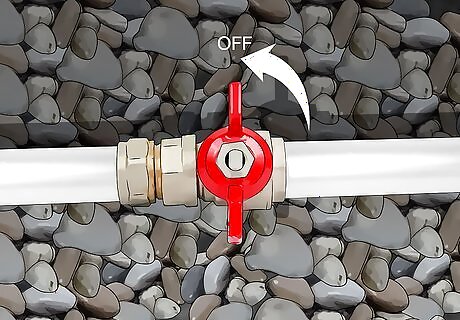
Turn off the water supply to your irrigation system. Make sure your irrigation system is turned off at the controller so it doesn’t turn on while you’re working. Look for the shut-off valve for your irrigation system either inside or outside near your water meter, and rotate the handle so it’s perpendicular to the pipe. Wait 2-3 minutes for the water to empty from your irrigation pipes and hoses before continuing so you don’t cause any additional leaks. Always keep your irrigation system’s water supply off while you make repairs or else water will constantly run through the pipes and make it difficult or messy to work with.
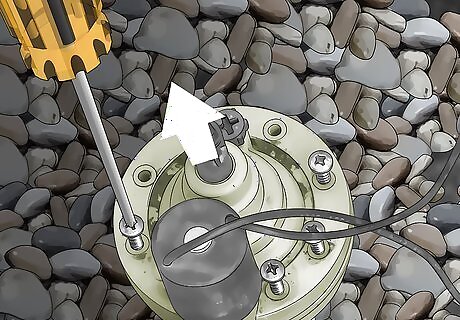
Unscrew the lid on your main valve to expose the rubber diaphragm. Check the valve box that’s leaking and locate the circular lid to the solenoid valve that has screws on top. Use a screwdriver to rotate the screws counterclockwise and set them in a small container so you don’t lose them in your yard. Pull the lid off of the valve to reveal a circular rubber piece, also known as the diaphragm. If you can’t easily access the lid on the valve due to flooding, then use a bucket or a turkey baster to get some of the water out of the way.Tip: If your valve doesn’t have a lid that easily screws off, you may need to unscrew the whole valve system by rotating it counterclockwise.
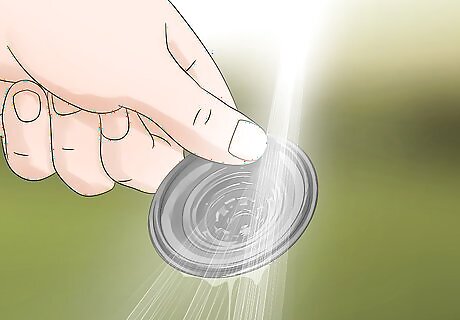
Rinse and dry the rubber diaphragm to remove any debris inside. Carefully pull the rubber diaphragm out of the valve and inspect it for any rips or tears. If the diaphragm still looks like it’s in good condition, run it underneath water from your sink or hose to clean off any dirt or debris that’s left on it. Use a dry cleaning rag to dry off the diaphragm and scrub any large pieces of debris that are sticking to it. If the diaphragm is cracked or worn out, then you can buy a replacement from an irrigation specialist or from most hardware stores. If you had to unscrew the entire valve, then it will have a rubber O-ring around the threading that you can clean or replace. Cleaning the diaphragm may also stop leaks that occur near the sprinkler heads.
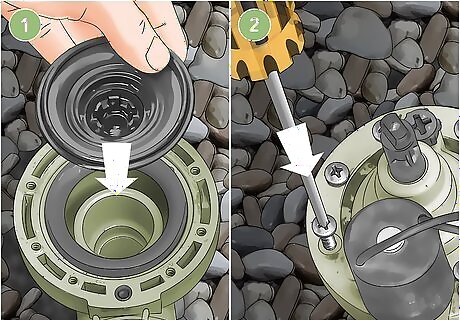
Reassemble the valve to test the irrigation system again. Place the rubber diaphragm back into the valve and check that it has a tight seal around the edge. Put the top lid back onto the valve and reattach the screws that hold it in place. Turn on the water supply for your irrigation system and watch the valve box to see if it still floods inside. If the box stays dry, then cleaning the diaphragm fixed the leak. If there is still a leak that occurs inside the valve box, the valve may be faulty and you need to have a professional replace it.
Checking the Sprinkler Connection
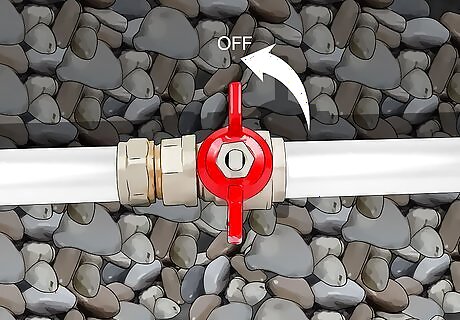
Turn off the water to your irrigation system. Make sure the irrigation controller is turned off so it doesn’t automatically turn on while you’re working. Locate the main shut-off valve for your irrigation system connected to an indoor or outdoor pipe near your water meter. Rotate the handle so it’s perpendicular to the pipe to ensure that water doesn’t flow through the pipes or hoses anymore.
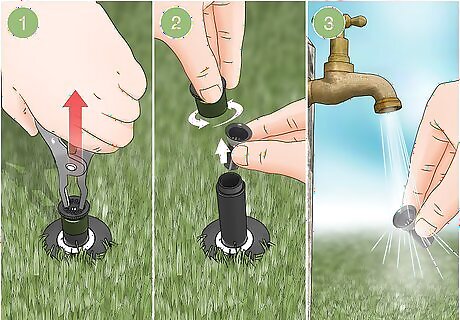
Clean the sprinkler head filter with water to see if it’s clogged. Grip the top of the sprinkler head with a pair of pliers and gently pull it up to raise the sprayer. Rotate the spray head counterclockwise to unscrew it from the base and remove the filter. Rinse the filter and sprayer under clean water to remove any clogs or debris before reattaching it to the sprinkler system. Rotate the sprinkler head until the sprayer points at your yard again. While cleaning out the filter won’t fix a leak, it will help prevent them in the future since clogs can cause the water pressure to build and burst a hose connection.
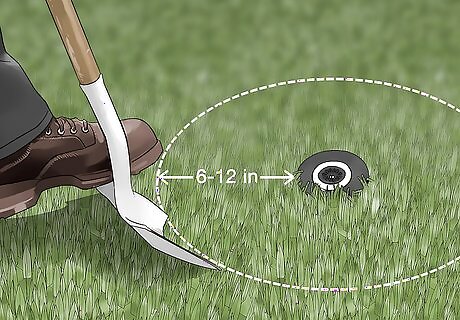
Dig up the ground around the sprinkler head that’s leaking. Start your shovel about 6–12 inches (15–30 cm) away from the sprinkler, and remove the soil and grass around it. Work slowly and carefully so you don’t break any hoses or pipes by accident, removing at least 6 inches (15 cm) of soil in each direction from the sprinkler. As you start to uncover more of the sprinkler head, use a small hand trowel or your hands to move the dirt and mud away to reveal the valve and hose connection on the bottom. If the ground is wet or muddy from the leak, try to remove as much of the wet mud as you can so the hoses and valves don’t get dirty.Warning: Contact your utility company before you start digging to see if there are any hidden power or gas lines underground. That way, you don’t risk accidentally rupturing one of them.
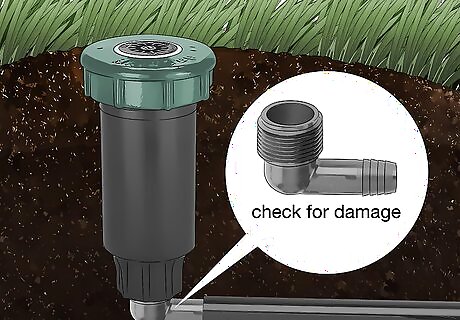
Replace the bottom valve on the sprinkler if it’s broken. Check the bottom L-shaped valve on the bottom of your sprinkler to see if it has any cracks or breaks. If it does, then rotate it counterclockwise to unscrew it from the bottom of the sprinkler head. Be sure to use a replacement valve that matches the shape and size of the existing valve or else the connection won’t fit. Screw the new valve clockwise onto the bottom of the sprinkler so you can use it again. You can buy replacement sprinkler valves from irrigation specialists or from hardware stores. If the valve wasn’t broken, then be sure to rinse it off with clean water so none of the mud or dirt gets inside the lines.
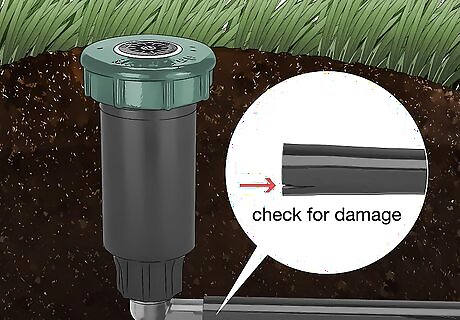
Look for cracks or bursts in the supply hose leading to the sprinkler head. If the valve wasn’t damaged, check the end of the hose that attaches directly to the valve. Sometimes, the hose will rupture if the sprinkler gets clogged or if the hose is old and damaged. Look for any cracks or broken seams on the end of the hose, and if there are any, then you need to repair the line. If the hose isn’t damaged and the sprinkler was leaking, then you may need to replace the entire sprinkler head since it may be damaged.
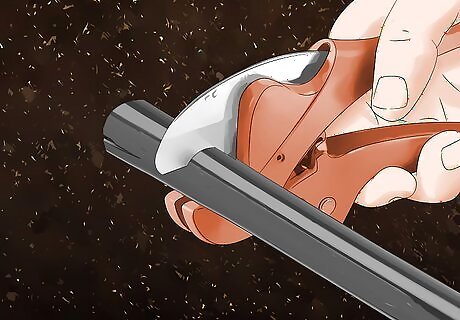
Cut off cracked sections of hose with a pipe cutter and wipe it clean. Make sure you remove the entire section of hose that’s cracked or damaged, or else it’s more susceptible to leaking in the future. Place the edge of your pipe cutter on the hose and pull the handles together to make a straight cut through it. Only remove as much as you need so you don’t need to attach a new section of hose. Use a cleaning rag to wipe the edges of your cut so no mud or dirt goes through your sprinkler head. If the entire hose seems old or cracked, then you may need to dig it up completely to replace it.
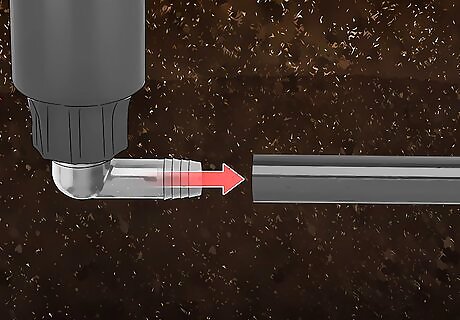
Push the sprinkler valve onto the hose so it has a secure fit. Push the end of the hose you just cut onto the bottom valve of the sprinkler. If the valve has threading, then rotate it onto the end of the hose. Otherwise, push the hose as far onto the valve as you’re able so it has a secure fit. You do not need to use any adhesives or pipe cement to hold it in place since the flanges will prevent water from escaping. If you aren’t able to push the hose onto the valve, dig up another 2–3 inches (5.1–7.6 cm) of the hose so you’re able to maneuver it around better.
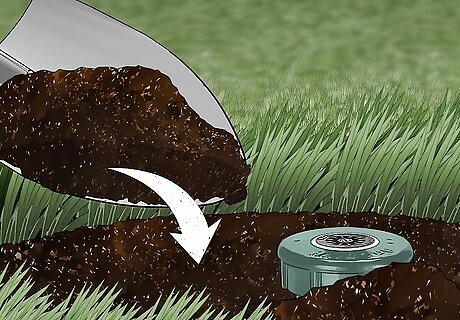
Fill in the hole so the top of the sprinkler is flush with the ground. Hold the sprinkler upright so it’s in the position that you want it, and start filling in dirt around it. Press the dirt tightly around the sprinkler head so it stays in place and doesn’t shift around while you’re working with it. Keep filling in the hole until the dirt or grass is flush with the top of the sprinkler. If you removed water and mud from the hole you dug, then fill the hole in with dry soil instead.
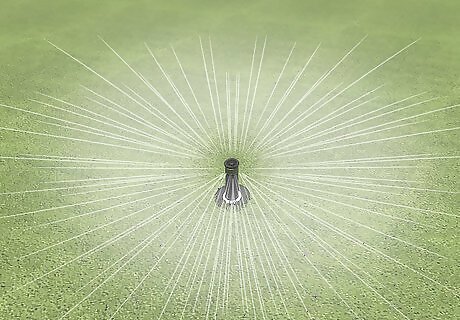
Turn on your sprinkler system to see if it still leaks. Turn the handle on the water supply valve so it’s parallel with the pipe to open it again. Rotate the dial on the irrigation system’s controller to the sprinkler you just fixed to make sure it works. If it’s spraying correctly and doesn’t have any pooling water, then the sprinkler is fixed. If the sprinkler still has an inconsistent spray, you may need to replace the sprinkler head entirely. If you notice water flooding or pooling next to sprinkler after fixing the hose, you may have a problem with one of the valves connected to that sprinkler.
Replacing a Section of Hose
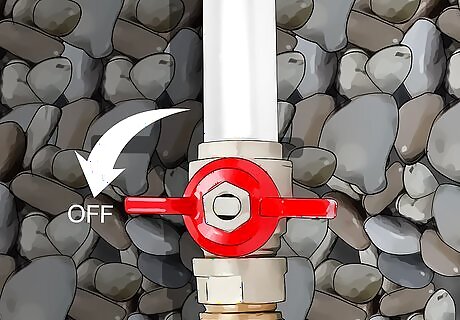
Shut off the water for the irrigation system. Make sure the controller for your irrigation system is in the “Off” position or else your sprinklers could start running while you’re working. Find the shut-off valve for your irrigation system on one of the interior or exterior pipes by your water meter, and rotate the handle so it’s perpendicular to the pipe. Wait 2-3 minutes for the water to cycle through the hoses before you start working. The hoses may still have a little residual water in them when you remove or repair them.
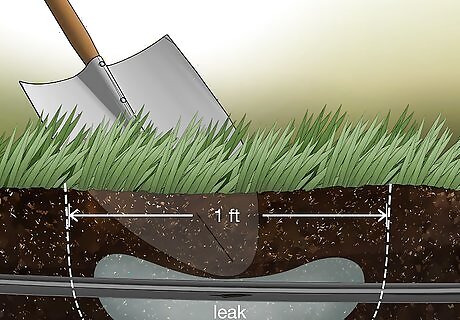
Dig up the area 12 in (30 cm) around the broken hose. Locate the area where you suspect the leak, and start carefully digging into the ground with a shovel. Don’t use a lot of force so you don’t accidentally break the hose while you’re digging. Dig out 12 inches (30 cm) horizontally from each side of the hose so you have room to work. Expose the broken section of the hose and 6 inches (15 cm) of excess on each side. Contact your local utility companies before you start digging to find out if there are any buried power or gas lines in your yard that you should avoid. If you dig up the hose and you still don’t see any damage, then the leak may be draining from a different area of your yard. Call a professional irrigation service if you can’t locate where the leaking hose is in your yard since they may be able to locate it for you.Tip: Clean out as much mud or water as you can with a bucket so the area is dry during your repair.
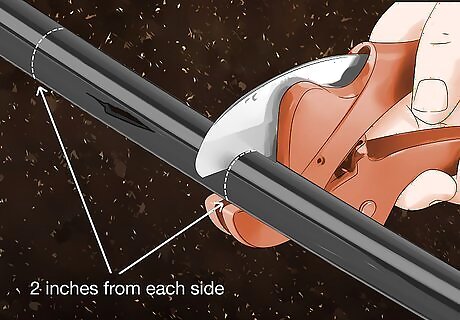
Remove the broken section of hose with pipe cutters. Measure at least 2 inches (5.1 cm) from each side of the ruptured hose and make a guide line using a marker. Open your pipe cutters and place the hose between the jaws. Squeeze the handles together to make a straight cut through the hose and remove the broken piece. If the entire hose looks cracked or damaged, then you may need to replace it completely.
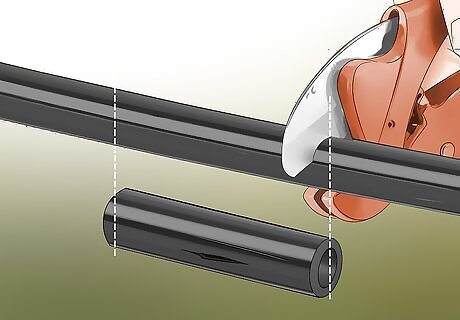
Cut a piece of hose that’s the same length as the section you just removed. Get a roll of PVC hosing from your local hardware store. Make sure you use a hose that’s the same diameter as the existing one so it’s able to fit together well. Use the piece of hose you just removed as a guide for cutting your new piece. Hold the old piece of hose up against the new piece and make your cuts with the pipe cutters. Many irrigation lines use ⁄10 in (1.8 cm) thick hoses, but it may vary depending on your system.
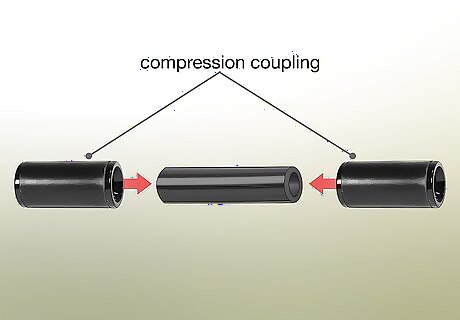
Fit a compression coupling onto either side of the new hose section. Compression couplings are pieces of PVC that connect 2 pieces of hose together with a watertight seal. Make sure to use compression couplings that match the size and diameter of your hose, or else they may leak. Slide the couplings halfway onto the ends of the piece of hose so they don’t move or slip around. Keep pushing the couplings on until it covers about 1–2 inches (2.5–5.1 cm) of the hose’s ends. You can buy compression couplings from your local hardware store. If you have trouble sliding the coupling onto the hose, wet the edges of the hose with clean water to push them in easier.
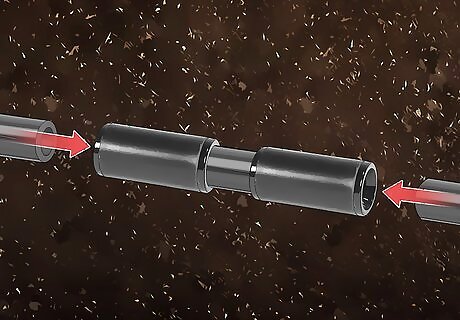
Slide the compression couplings onto the cut ends of the buried hose. Once the compression couplings are on your new piece of hose, then push the other end of the coupling onto the hose that’s buried in the ground. Make sure about 1–2 inches (2.5–5.1 cm) of the hose goes into the coupling so it has a tight connection. If you need to, wet the ends of the hose to make it easier to push into the couplings. You do not need to use any adhesives or waterproofing material to secure the couplings since they are already watertight.
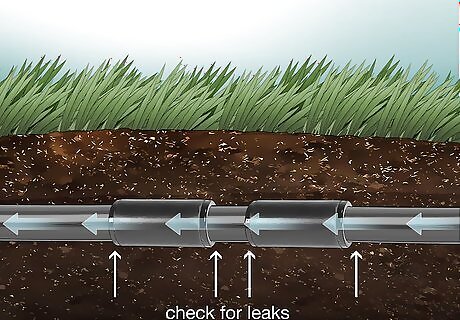
Turn on your water supply to check if the hose leaks before filling in the hole. Open the shut-off valve to your irrigation system and turn on the controller to the area you’re working on. Watch the hose for any leaks or water spraying out of it to see if the couplings worked. If they do, then start filling in the hole you dug with fresh, dry soil and pack it down tightly to hold it in place. If the couplings do not work, then you may need to dig up and replace the entire hose to fix it.




















Comments
0 comment